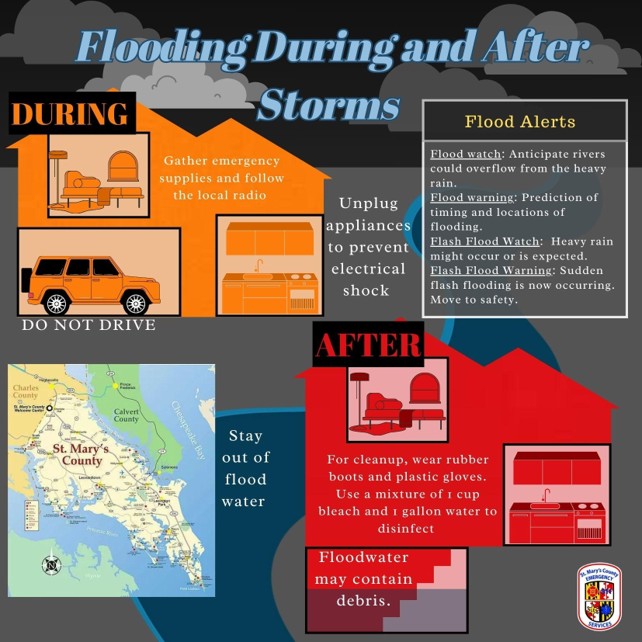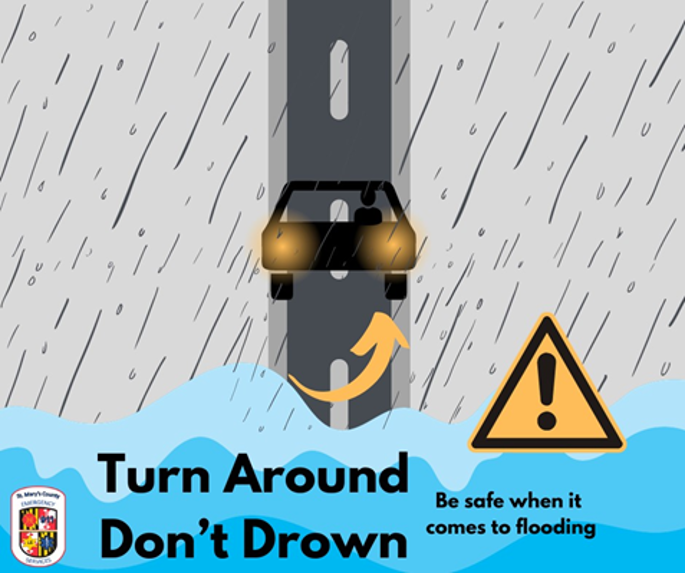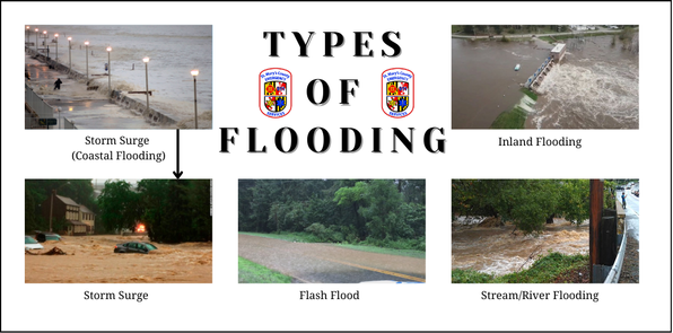Flooding
Flooding is an overflow of water that submerges land that is usually dry. There are different kinds of flooding including coastal flooding, flash flooding, and riverine flooding. St. Mary’s County is a coastal community, bordered by the Chesapeake Bay and Potomac River. Given the large number of people that can be affected by flooding, high economic costs, and moderate response costs, the vulnerability to flooding is high in St. Mary’s County.
Flood Maps - find out your flood risk
The Federal Emergency Management Agency (FEMA) creates flood maps, known as Flood Insurance Rate Maps (FIRMs), to show high and moderate risk areas. FIRMs are updated every five years. To check your flood risk, look up your address in the FEMA Flood Map Service Center.
It is important to note that flood maps provide a guide to flood-prone areas, but it is impossible to predict all flooding. Many areas outside the high-risk flood zone can flood. For example, if you live in an urban or suburban area, you might be at risk from flooding due to stormwater runoff.
Flood Insurance – protect your home and property from flood loss

Flood insurance is the only insurance type that will cover the damage from flooding. Flood insurance takes 30 days to begin from the time of purchase, so be sure to insure your home before it’s too late. Visit https://www.floodsmart.gov/how-buy-flood-insurance to learn about purchasing flood insurance or speak with your insurance agent.
National Flood Insurance Program - The National Flood Insurance Program (NFIP) is a federal program administered by FEMA, which makes federally backed flood insurance available to homeowners, renters and business owners. Insurance costs vary depending on how much insurance is purchased, what it covers and the property's flood risk. In order to qualify for flood insurance, the County must participate in the NFIP. St. Mary’s County has been a participant since February 19, 1987.
Mandatory Purchase of Flood Insurance
Pursuant to the Flood Disaster Protection Act of 1973 and the National Flood Insurance Reform Act of 1994, the purchase of flood insurance is mandatory for all federal or federally related financial assistance for the acquisition and, or construction of buildings in Special Flood Hazard Areas. Special Flood Hazard Areas are defined as any A or V flood zones on a FEMA Flood Insurance Rate Map (FIRM).
The mandatory purchase requirement also applies to secured loans from such financial institutions as commercial lenders, savings and loan associations, savings banks, and credit unions that are regulated, supervised, or insured by federal agencies, such as the Federal Reserve, the Federal Deposit Insurance Corporation, the Comptroller of Currency, the Farm Credit Administration, the Office of Thrift Supervision, and the National Credit Union Administration. Additionally, all loans purchased by Fannie Mae or Freddie Mac in the secondary mortgage market are subject to the mandatory requirement for flood insurance.
The requirement for mandatory insurance applies to real property when a building or portion of a building is in a Special Flood Hazard Area. However, lenders, own their initiatives, may require the purchase of flood insurance even though a building may be entirely outside a Special Flood Hazard Area.
Who has a Mandatory Purchase Requirement?
Maryland Insurance Administration
To learn more about floodplain management, development in a floodplain, and flood insurance requirements, visit the St. Mary’s County Land Use and Growth Management (LUGM) page at https://www.stmaryscountymd.gov/LUGM/FPM/
Get prepared!
During a Flood:
- Follow the instructions of local officials and emergency responders.
- Depending on the type of flooding:
- Evacuate if told to do so.
- Move to higher ground or a higher floor.
- Stay where you are.
- Call 9-1-1 if you are trapped and in danger, or if you need medical assistance.
- Turn Around, Don’t Drown! Do not walk, drive, or swim through flood waters.
After a Flood:
- Follow the instructions of local officials and emergency responders.
- Avoid driving except in emergencies.
- Wear heavy work gloves, protective clothing, and boots during clean up and use appropriate face coverings or masks if cleaning mold or other debris.
- Be aware that snakes and other animals may be in your house.
- Do not touch electrical equipment if it is wet or if you are standing in water. Turn off electricity to prevent electric shock if it is safe to do so.


For more information about preparing for a floods, please visit:
Flood Insurance | FEMA.gov
Floodplain Management | FEMA.gov
Flood Maps | FEMA.gov
Why Buy Flood Insurance | FloodSmart
https://www.stmaryscountymd.gov/ES/HazardMitigation/
Be flood prepared! Watch the video for more information.
Watch this video to learn more about coastal flooding!
Watch this video to learn more about flash flooding!
Different type of floods
Storm Surge
Storm surge is defined as an extreme rise in water level in coastal areas caused by severe storms wind, waves, and low atmospheric pressure.
The following can all affect storm surge:
- Central pressure
- Wind speed & direction
- Angle of approach
- Local features such as coastlines, bays, rivers, highlands, or islands

Coastal Flooding
Coastal flooding occurs when wind blows water from the ocean to landward areas along the coast. This is caused by higher-than-average high tide and worsened by heavy rainfall and onshore winds. Areas with lower elevation are most vulnerable.
- Minor: Slight amount of beach erosion can occur, but major damages are not likely
- Moderate: A fair amount of beach erosion and damage to some structures
- Major: Serious threat to life and property. Large-scale beach erosion will occur, numerous roads will be flooded, and many structures will be damaged. Citizens should review safety precautions and prepare for a possible evacuation.
Flash Flooding
Flash flooding is rapid flooding in low-lying areas. Flash flooding is caused by sudden intense or excessive rainfall in a short period of time, generally less than six hours. When this happens, the ground cannot absorb the water as quickly as the rain falls.
Inland Flooding
As indicated by the name, inland flooding occurs in inland areas miles from the coast. There may be moderate precipitation accumulated over several days, intense precipitation which falls over a short period, the overflow of a due to ice or debris jam, or dam levee failure.
Stream/ River Flooding
Stream and river flooding occur when there is excessive rainfall over an extended period causing an overflow over the edges of the river or stream. This can also happen from heavy snow/ice melt. The severity of a river flood is determined by the amount of precipitation in an area, how long it takes for precipitation to accumulate, previous saturation of local soils, and the terrain surrounding the river system.
